2. 中国石油勘探开发研究院廊坊分院, 河北 廊坊 065007
2. Langfang Branch Research Institute of Petroleum Exploration and Development, PetroChina, Langfang, Hebei 065007, China
致密油是指以吸附或游离状态赋存于生油岩中,或与生油岩互层、紧邻的致密砂岩、致密碳酸盐岩等储集岩中,未经过大规模长距离运移的石油聚集。一般按基质覆压渗透率0.1 mD(气测渗透率1 mD),作为致密油储层渗透率上限[1-6]。
致密油资源具有分布广、富集区零散、埋藏深、储层致密的特点。渗流阻力大,通常油井自然产能低,依靠常规技术无法实现规模效益动用[7-13]。致密油储层致密,开发难度大,依据裂缝发育程度和基质物性好坏的不同,致密油储层又可划分为不同的类型。对每种储层类型下的生产特征进行研究,对致密油开发部署具有非常重要的意义[14-19]。
本文针对不同类型储层建立了不同的油藏数值模拟模型,进行计算,研究了不同类型储层的生产特征,并以中国某典型致密油储层为例,对其中4口单井的生产特征与数模结果进行了对比分析。
1 储层类型划分致密油储层通常发育毫米-微米-纳米级多级孔喉系统,其中以纳米级孔隙为主,微米级孔隙次之,局部可能发育孔径较大的毫米级孔隙。致密油储层通常也会发育不同程度的天然裂缝,由构造作用形成的宏观缝,通常缝宽较大,宏观缝可在大范围内沟通基质和微裂缝,是高产的重要条件;由成岩作用、构造作用和溶蚀作用形成的微缝,通常缝宽较小,起渗流通道的作用,沟通范围极其有限[1-4]。
依据天然裂缝和孔隙的发育情况,致密油储层可划分为以下4种类型,如表 1所示,(1) 孔隙型,储层发育常规及微纳米孔隙,常规孔隙是其主要储集空间,其渗流能力和储集能力较强;(2) 裂缝-孔隙型,储层以微纳米孔隙为主,裂缝发育,因此基质物性较差,天然裂缝是主要的渗流通道,基质通过裂缝向井筒窜流,为双孔单渗型;(3) 孔隙-裂缝型,孔隙以常规孔隙为主,发育天然裂缝,基质物性较好,天然裂缝和基质共同渗流,为双孔双渗型;(4) 裂缝型,通常位于断裂及裂缝发育区,除了发育由构造作用形成大裂缝,还发育大量微裂缝,裂缝既是渗流通道也是储集空间。
2 模型建立| 表1 储层类型划分 Table 1 The classifications of tight oil reservoirs |
参考了典型的致密油储层G油田的相关数据,按照4类储层的特点,建立了相应的数值模拟模型。4类储层的基本参数如表 2所示,其他基本参数如表 3所示。
| 表2 数值模拟基本孔渗参数 Table 2 The parameters of permeability and porosity |
| 表3 数值模拟其他基本参数 Table 3 The parameters for reservoir simulation |
(1) 对于孔隙型储层来说,其产量曲线(图 1)特点是初期产量较低,但是递减缓慢,产量水平维持较稳定。在孔隙型储层中,基质不仅是储集空间,更是主要的渗流通道,因此其单井产能通常较低,但是由于基质良好的储集和供给能力,因此可以维持较长的低产、稳产时间,其单井的生命周期通常较长。如图 1所示,模型预测20 a,单井累产可达8 000 m3。
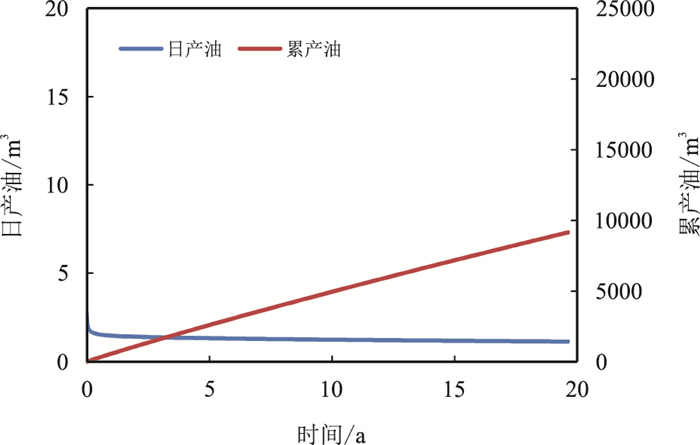 |
| 图1 孔隙型储层单井产量曲线 Fig. 1 Production performance curves of porous type reservoirs |
(2) 对于裂缝-孔隙型储层,其产量曲线(图 2)的特点是初期产量较高,递减较快,初期阶段约持续4
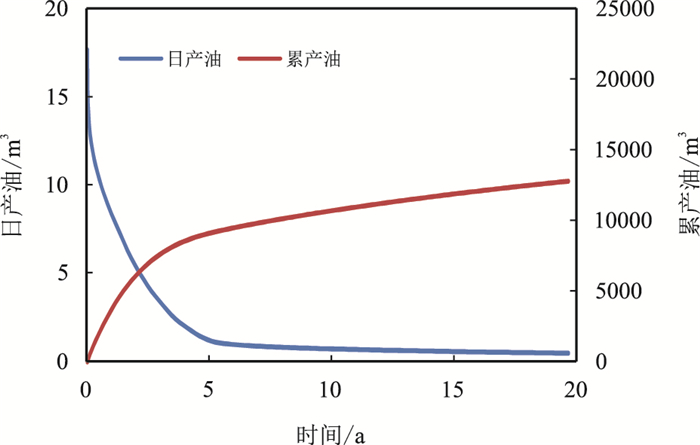 |
| 图2 裂缝-孔隙型储层单井产量曲线 Fig. 2 Production performance curves of fracture-porous type reservoirs |
(3) 对于孔隙-裂缝型储层,其产量曲线(图 3)的特点是初期产量较高,但是递减稍快,初期阶段约维持7
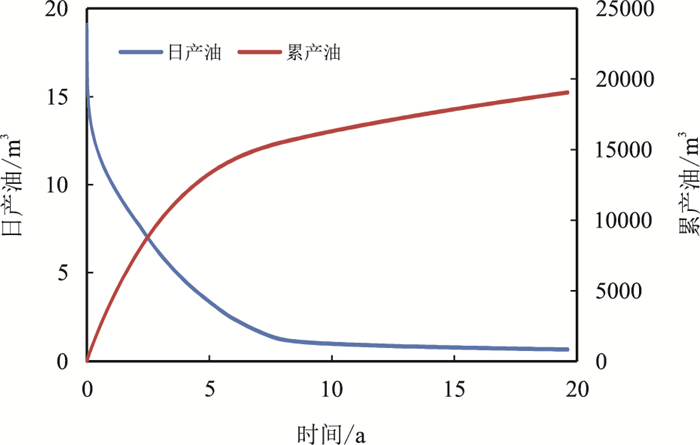 |
| 图3 孔隙-裂缝型储层单井产量曲线 Fig. 3 Production performance curves of porous-fracture type reservoirs |
初期阶段裂缝和基质共同作用,随着裂缝中储量被不断地采出,基质的供给逐渐占主导地位。孔隙-裂缝型储层中通常以常规孔隙为主,其储集能力和导流能力都很好,因此其递减相对较慢,高产阶段较长,累产较高。
(4) 对于裂缝型储层,其产量曲线(图 4)特点是初期产量较高,递减非常快,年平均递减率高达70%。经过3
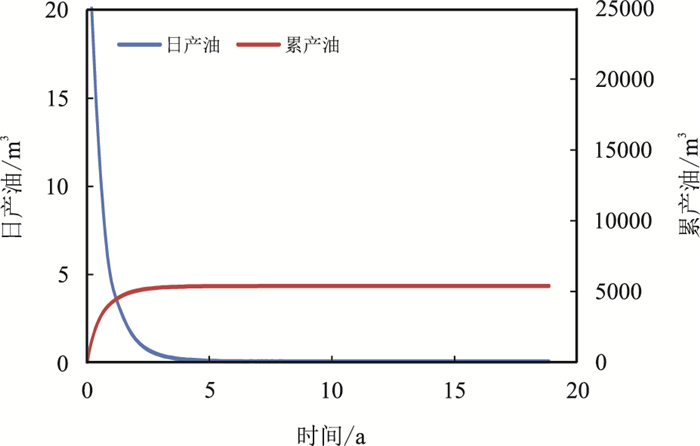 |
| 图4 裂缝型储层单井产量曲线 Fig. 4 Production performance curves of fracture types of reservoirs |
综合4种类型曲线分析,如图 5所示,从初期递减率来看,裂缝型递减最快,裂缝-孔隙型次之,孔隙-裂缝型再次之,孔隙型递减最慢。从20 a累产来看,孔隙-裂缝型累产最高,裂缝-孔隙型次之,孔隙型再次之,裂缝型最低。孔隙型20 a末累产虽然高于裂缝型,但是孔隙型产量上升缓慢,其生产特征与致密油开发需快速收回投资的模式是矛盾的,但是孔隙型储层存储能力较强,具有一定的开发潜力,结合适当的储层改造技术,孔隙型储层的开发潜力将得到较大的提高。
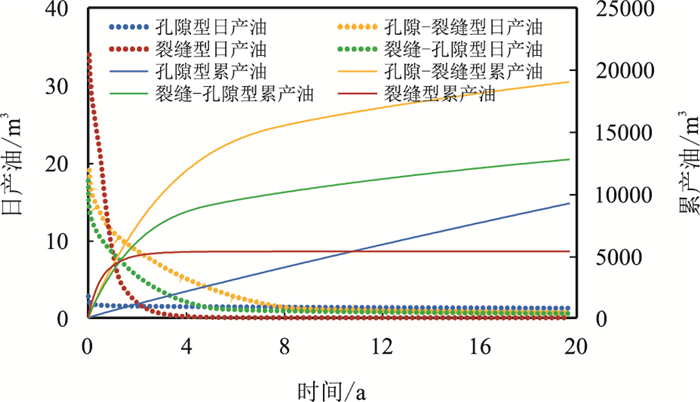 |
| 图5 4种类型储层单井产量曲线 Fig. 5 Production performance curves of four type reservoirs |
从图 6可以看出,由于裂缝-孔隙型储层中,储层的基质物性较好,基质中的储量较早较快地被采出,基质贡献效率比裂缝-孔隙型要快,因此,初期阶段时间较长(约7
 |
| 图6 孔隙-裂缝型与裂缝孔隙型储层不同阶段采出比例对比 Fig. 6 The comparison of cumulative production percentage between porous-fracture type and fracture-porous type in earlier and later period |
从图 7可以看出,前3 a采出比例最大的是裂缝型,采出比例最小的是孔隙型仅为18%,对于裂缝-孔隙型和孔隙-裂缝型采出比例均大于50%。为了符合致密油快速收回投资的开发模式,应采用合适的储层改造方式,加快孔隙型、双孔渗型、双孔单渗型储层的开采速度,尽量在短时间内收回投资。
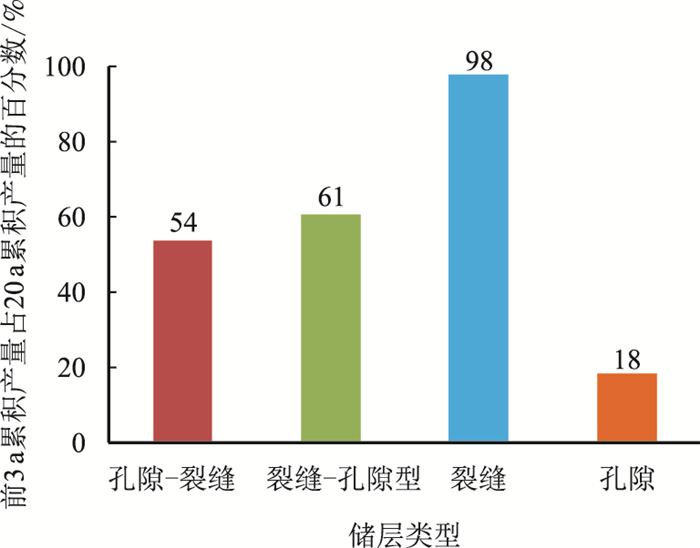 |
| 图7 前3年累积产量占20年累积产量比 Fig. 7 The ratio of the cumulative production of the past 3 years to that of 20 years |
中国G油田储层物性差,其平均孔隙度为1%
 |
| 图8 4口井产量曲线 Fig. 8 Production curves for 4 wells |
结合4口井的生产曲线(图 8)以及前3 a累积产量占总产量的比例(图 9),可以看出4口井的产量曲线变化特征和趋势与本文前述的4种类型单井的特征符合。实际井前3 a的产出比例与数值模拟计算的结果也比较一致。
 |
| 图9 实际井与数模结果对比 Fig. 9 History and match results comparison |
(1) 在初期阶段裂缝贡献较大,并逐渐减少,基质贡献较小,但是逐渐增大。裂缝是初期高产的必要条件,而良好的基质物性则是长期稳产的必要条件。
(2) 致密油开发不能一味追求单井累产,而要快速收回投资,因此,对于孔隙型、裂缝-孔隙型及孔隙-裂缝型储层来说,需通过适当的储层改造技术,提高前期的采出程度。
| [1] |
贾承造, 郑民, 张永峰. 中国非常规油气资源与勘探开发前景[J].
石油勘探与开发, 2012, 39 (2) : 129 –136.
Jia Chengzao, Zheng Min, Zhang Yongfeng. Unconventional hydrocarbon resources in China and the prospect of exploration and development[J]. Petroleum Exploration and Development, 2012, 39 (2) : 129 –136. |
| [2] |
贾承造, 邹才能, 李建忠, 等. 中国致密油评价标准、主要类型、基本特征及资源前景[J].
石油学报, 2012, 33 (3) : 343 –350.
Jia Chengzao, Zou Caineng, Li Jianzhong, et al. Assessment criteria, main types, basic features and resource prospects of the tight oil in China[J]. Acta Petrolei Sinica, 2012, 33 (3) : 343 –350. |
| [3] |
焦翠华, 王清辉, 徐怀民, 等. 准东地区北部二叠系致密油藏烃源岩测井评价[J].
新疆石油地质, 2013, 34 (5) : 524 –527.
Jiao Cuihua, Wang Qinghui, Xu Huaimin, et al. The logging evaluation of source rocks in Permian tight oil reservoir in Northern East Junggar Basin[J]. Xinjiang Petroleum Geology, 2013, 34 (5) : 524 –527. |
| [4] |
潘晓添, 郑荣才, 文华国, 等. 准噶尔盆地乌尔禾地区风城组云质致密油储层特征[J].
成都理工大学学报:自然科学版, 2013, 40 (3) : 315 –325.
Pan Xiaotian, Zheng Rongcai, Wen Huaguo, et al. Tight oil reservoir of Permian Fengcheng Formation in Urho area, Junggar Basin, China[J]. Journal of Chengdu University of Technology:Science & Technology Edition, 2013, 40 (3) : 315 –325. |
| [5] | 景东升, 丁锋, 袁际华. 美国致密油勘探开发现状、经验及启示[J]. 国土资源情报, 2012 (1) : 18 –19, 45. |
| [6] | 孙赞东, 贾承造, 李相方, 等. 非常规油气勘探与开发(上册)[M]. 北京: 石油工业出版社, 2011 . |
| [7] | Flores C P, Holditch S A, Ayers W B. Economics and technology drive development of unconventional oil and gas reservoirs:Lessons learned in the united states[C]. SPE 146765, 2011. |
| [8] |
林森虎, 邹才能, 袁选俊, 等. 美国致密油开发现状及启示[J].
岩性油气藏, 2011, 23 (4) : 25 –30, 64.
Lin Senhu, Zou Caineng, Yuan Xuanjun, et al. Status quo of tight oil exploitation in the United States and its implication[J]. Lithologic Reservoirs, 2011, 23 (4) : 25 –30, 64. |
| [9] | Faisal Rasdi, Chu L. Diagnosing fracture network pattern and flow regime aids production performance analysis in unconventional oil reservoirs[C]. SPE 151623, 2012. |
| [10] |
窦宏恩, 马世英. 巴肯致密油藏开发对我国开发超低渗透油藏的启示[J].
石油钻采工艺, 2012, 34 (2) : 120 –124.
Dou Hong'en, Ma Shiying. Lessons learned from oil production of tight oil reservoirs in Bakken play[J]. Oil Drilling & Production Technology, 2012, 34 (2) : 120 –124. |
| [11] |
邹才能, 张国生, 杨智, 等. 非常规油气概念、特征、潜力及技术——兼论非常规油气地质学[J].
石油勘探与开发, 2013, 40 (4) : 385 –399, 454.
Zou Caineng, Zhang Guosheng, Yang Zhi, et al. Geological concepts, characteristics, resource potential and key techniques of unconventional hydrocarbon:on unconventional petroleum geology[J]. Petroleum Exploration and Development, 2013, 40 (4) : 385 –399, 454. |
| [12] |
王晓泉, 张守良, 吴奇, 等. 水平井分段压裂多段裂缝产能影响因素分析[J].
石油钻采工艺, 2009, 31 (1) : 73 –76.
Wang Xiaoquan, Zhang Shouliang, Wu Qi, et al. Factors affecting the productivity of multi-section fractures in subsection fracturing of horizontal wells[J]. Oil Drilling & Production Technology, 2009, 31 (1) : 73 –76. |
| [13] |
郎兆新, 张丽华, 程林松. 压裂水平井产能研究[J].
石油大学学报:自然科学版, 1994, 18 (2) : 43 –46.
Lang Zhaoxin, Zhang Lihua, Cheng Linsong. Investigation on productivity of fractured horizontal well[J]. Journal of the University of Petroleum, China, 1994, 18 (2) : 43 –46. |
| [14] | 颜磊, 刘立宏, 李永明, 等. 水平井重复压裂技术在美国巴肯油田的成功应用[J]. 国外油田工程, 2010, 26 (12) : 21 –25. |
| [15] | 郭平, 张茂林, 黄全华, 等. 低渗透致密砂岩气藏开发机理研究[M]. 北京: 石油工业出版社, 2009 : 1 -253. |
| [16] | Duong A N. An unconventional rate decline approach for tight and fracture-dominated gas wells[C]. SPE 137748, 2010. |
| [17] | Besler M R, Steele J W, Egan T, et al. Improving well productivity and profitability in the bakken-a summary of our experiences drilling, stimulating, and operating horizontal wells[C]. SPE 110679, 2007. |
| [18] | Tabatabaei M, Mack D J, Daniels N R. Evaluating the performance of hydraulically fractured horizontal wells in the bakken shale play[C]. SPE 122570, 2009. |
| [19] | Clarkson C R, Pedersen P K. Production analysis of western canadian unconventional light oil plays[C]. SPE 149005, 2011. |
 2015, Vol. 37
2015, Vol. 37


